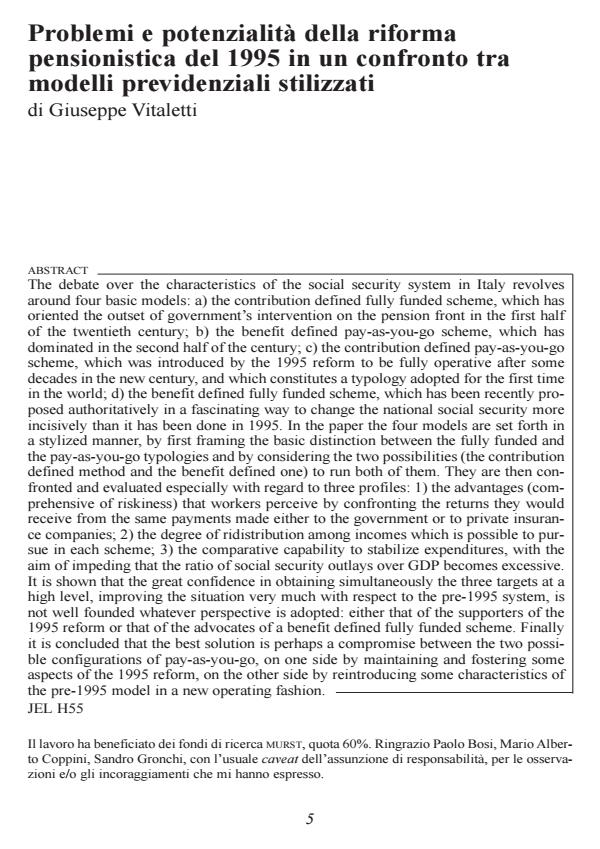Problemi e potenzialità della riforma pensionistica del 1995 in un confronto tra modelli previdenziali stilizzati
Titolo Rivista ECONOMIA PUBBLICA
Autori/Curatori Giuseppe Vitaletti
Anno di pubblicazione 1 Fascicolo 2000/4
Lingua Italiano Numero pagine 48 P. Dimensione file 157 KB
DOI
Il DOI è il codice a barre della proprietà intellettuale: per saperne di più
clicca qui
Qui sotto puoi vedere in anteprima la prima pagina di questo articolo.
Se questo articolo ti interessa, lo puoi acquistare (e scaricare in formato pdf) seguendo le facili indicazioni per acquistare il download credit. Acquista Download Credits per scaricare questo Articolo in formato PDF

FrancoAngeli è membro della Publishers International Linking Association, Inc (PILA)associazione indipendente e non profit per facilitare (attraverso i servizi tecnologici implementati da CrossRef.org) l’accesso degli studiosi ai contenuti digitali nelle pubblicazioni professionali e scientifiche
The debate over the characteristics of the social security system in Italy revolves around four basic models: a) the contribution defined fully funded scheme, which has oriented the outset of government’s intervention on the pension front in the first half of the twentieth century; b) the benefit defined pay-as-you-go scheme, which has dominated in the second half of the century; c) the contribution defined pay-as-you-go scheme, which was introduced by the 1995 reform to be fully operative after some decades in the new century, and which constitutes a typology adopted for the first time in the world; d) the benefit defined fully funded scheme, which has been recently proposed authoritatively in a fascinating way to change the national social security more incisively than it has been done in 1995. In the paper the four models are set forth in a stylized manner, by first framing the basic distinction between the fully funded and the pay-as-you-go typologies and by considering the two possibilities (the contribution defined method and the benefit defined one) to run both of them. They are then confronted and evaluated especially with regard to three profiles: 1) the advantages (comprehensive of riskiness) that workers perceive by confronting the returns they would receive from the same payments made either to the government or to private insurance companies; 2) the degree of ridistribution among incomes which is possible to pursue in each scheme; 3) the comparative capability to stabilize expenditures, with the aim of impeding that the ratio of social security outlays over GDP becomes excessive. It is shown that the great confidence in obtaining simultaneously the three targets at a high level, improving the situation very much with respect to the pre-1995 system, is not well founded whatever perspective is adopted: either that of the supporters of the 1995 reform or that of the advocates of a benefit defined fully funded scheme. Finally it is concluded that the best solution is perhaps a compromise between the two possible configurations of pay-as-you-go, on one side by maintaining and fostering some aspects of the 1995 reform, on the other side by reintroducing some characteristics of the pre-1995 model in a new operating fashion.
Giuseppe Vitaletti, Problemi e potenzialità della riforma pensionistica del 1995 in un confronto tra modelli previdenziali stilizzati in "ECONOMIA PUBBLICA " 4/2000, pp , DOI: